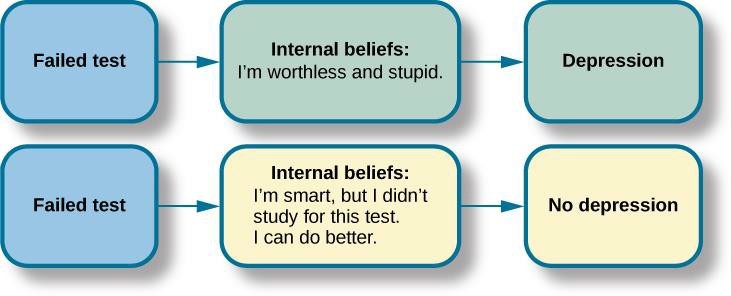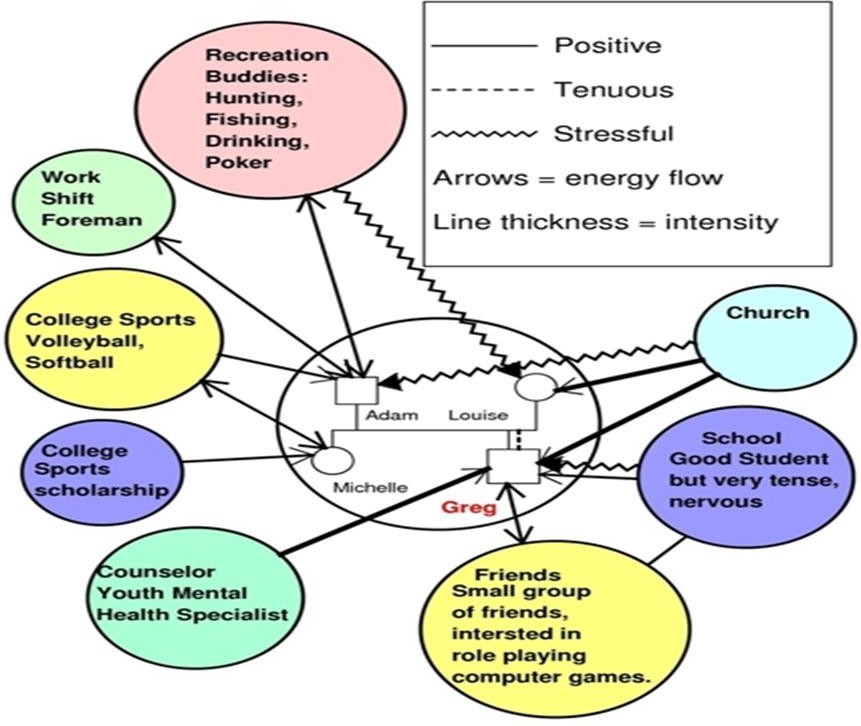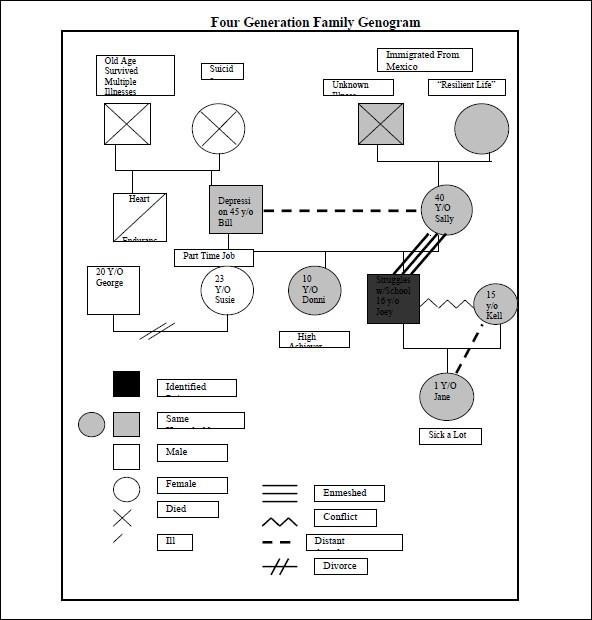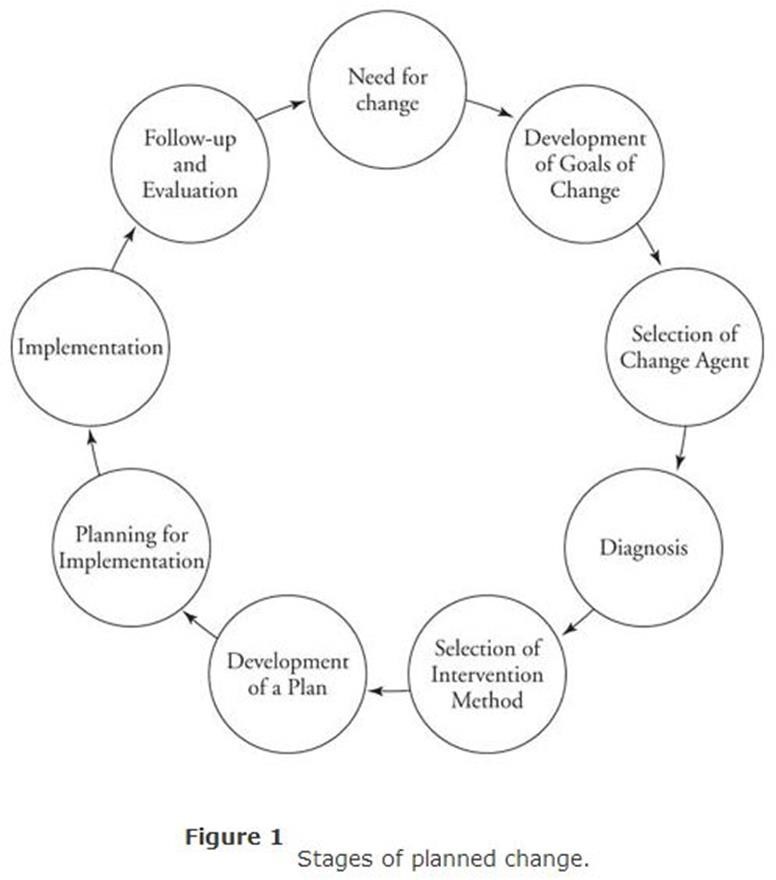7 Generalist Practice
Learning Objectives
In this chapter, the student will be reviewing the following:
- The meaning of generalist practice
- Review micro, mezzo, and macro social work
- A brief overview of intervention modalities
- Important social work theories
- Application of 2 Assessment tools: ecomap and genogram
- An overview of the planned change process
When looking at generalist practice primary theories, the first question that may come to mind is what is generalist practice? Generalist practice introduces students to the basic concepts in social work which includes promoting human well-being and applying preventative and intervention methods to social problems at individual (micro), group (mezzo), and community (macro) levels while following ethical principles and critical thinking (Inderbitzen, 2014).
Now that you have some insight into what generalist practice is, we should discuss what a social work generalist does. A social work generalist uses a wide range of prevention and intervention methods when working with families, groups, individuals, and communities to promote human and social well-being (Johnson & Yanca, 2010).
Being a social work generalist practitioner prepares you to enter any profession within the social work field, depending on your population of interest (Inderbitzen, 2014). Some professions within the social work field include but are not limited to Medical social worker, school social worker, community outreach, human services, etc.
Micro, Mezzo, Macro Levels of Social Work
MICRO: Micro level social work is the most widespread practice scenario and happens directly with an individual client or family; in most cases this is case management and therapy service. Micro social work involves meeting with individuals, families, or small groups to help identify, and manage emotional, social, financial, or mental challenges, such as helping individuals to find appropriate housing, health care, and social services.
MEZZO: The major difference between micro and mezzo level social work is that instead of engaging in individual counseling and support, mezzo social workers administer help to groups of people. There are many diverse types of groups that involve social workers: task, therapy, education, self-help, support, and psychoeducation. The following is a brief description of these types of groups:
- Task: These are groups that are organized for a specific action, such as assisting other professionals on a child’s education plan or working with other social workers to organize a fundraising event.
- Therapy: These groups are designed to assist group members with problematic feelings, behaviors, or thoughts. Such groups can be short-term or long-term, and such groups address issues of trauma, depression, anxiety, and domestic violence groups, to name a few.
- Education: Groups that are organized to aid group members in the learning of added information, such as stress management or parenting skills.
- Self-help: Groups that may or may not be led by social workers and focus on peer support for some presenting issue or concerns, such as addictions, a chronic illness, weight loss, to name a few.
- Support: Like self-help groups, the support group is organized for the basic support and encouragement of members facing similar issues, such as a bereavement group, a “parent with teens” group, or parents meeting to address school bullying.
- Psychoeducation: These groups are about the dissemination of information and an educational process with the added focus on individual growth. Such groups might include educating clients about certain disorders, such as depression or anxiety, and utilizing a particular treatment modality, such as solution-focused therapy.
MACRO: Macro level social work is very distinct from micro and mezzo level. The focus of macro level social work is to help vulnerable populations indirectly and on a larger scale. The responsibilities for social workers on a macro level typically are finding the root cause or the why and effects of citywide, state, and/or national social problems.
Social workers that work on the macro level are often employed at non-profit organizations, public defense law firms (working pro-bono cases), government departments, and human rights organizations.
Treatment Modalities
In individual therapy, also known as individual psychotherapy or individual counseling, the client and clinician meet one-on-one (usually from 45 minutes to 1 hour). These meetings typically occur weekly or every other week, and sessions are conducted in a confidential and caring environment (Figure). The clinician will work with clients to help them explore their feelings, work through life challenges, identify aspects of themselves and their lives that they wish to change, and set goals to help them work towards these changes. A client might see a clinician for only a few sessions, or the client may attend individual therapy sessions for a year or longer. The amount of time spent in therapy depends on the needs of the client as well as the client’s personal goals.
Family therapy is a special form of group therapy, consisting of one or more families. Although there are many theoretical orientations in family therapy, one of the most predominant is the systems approach. The family is viewed as an organized system, and everyone within the family is a contributing member who creates and maintains processes within the system that shape behavior (Minuchin, 1985). Each member of the family influences and is influenced by the others. The goal of this approach is to enhance the growth of each family member as well as that of the family.
Types of Treatment
Solution focused therapy
Questions and compliments are the primary tools of the solution-focused approach. SF therapists and counselors deliberately refrain from making interpretations.[3] and rarely confront their clients. Instead, they[3] focus on identifying the client’s goals, generating a detailed description of what life will be like when the goal is accomplished, and the problem is either gone or coped with satisfactorily. To develop effective solutions, they search diligently through the client’s life experiences for “exceptions”, e.g., times when some aspect of the client’s goal was already happening utilizing these to co-construct uniquely appropriate and effective solutions.[10]
Multi-cultural Perspective
This is not so much a specific change model as it is lens for the change process in general. Such a perspective suggests that our change models have exclusively been grounded in a European, monocultural perspective. As such there has been a disregard for more multicultural worldviews as related to change orientations. However, as has been noted about the NASW (National Association of Social Workers) Code of Ethics, it is the responsibility of the culturally competent social worker to offer a “set of knowledge, behaviors, attitudes, skills, and policies that enables a practitioner to work effectively in a multicultural situation.”
What might be some interventions that reflect such multicultural sensitivities? The social worker might include the following in their multicultural practice:
- Holistic approaches based on Eastern philosophies.
- Use of storytelling, folklore.
- Use of a cultural genogram.
- Incorporation of music, art, poetry, journaling.
- Integrate more contemplative practices, such as yoga, meditation, creative visualization, indigenous healing, or folk healers.
Narrative therapy
The narrative therapist focuses upon assisting people to create stories about themselves, about their identities, that are helpful to them. This work of “re- authoring identity” claims to help people identify their own values and identify the skills and knowledge they must live these values. Through the process of identifying the history of values in people’s lives, the therapist can co-author a new story about the person.[6]
Play therapy is often used with children since they are not likely to sit on a couch and recall their dreams or engage in traditional talk therapy. This technique uses a therapeutic process of play to “help clients prevent or resolve psychosocial difficulties and achieve optimal growth” (O’Connor, 2000, p. 7). The idea is that children play out their hopes, fantasies, and traumas while using dolls, stuffed animals, and sandbox figurines (Figure). Play therapy can also be used to help a therapist make a diagnosis. The therapist observes how the child interacts with toys (e.g., dolls, animals, and home settings) to understand the roots of the child’s disturbed behavior.
Cognitive therapy is a form of psychotherapy that focuses on how a person’s thoughts lead to feelings of distress. The idea behind cognitive therapy is that how you think determines how you feel and act. Cognitive therapists help their clients change dysfunctional thoughts to relieve distress. They help a client see how they misinterpret a situation (cognitive distortion). For example, a client may overgeneralize. Because Ray failed one test in his Psychology 101 course, he feels he is stupid and worthless. These thoughts then cause his mood to worsen. Therapists also help clients recognize when they blow things out of proportion. Because Ray failed his Psychology 101 test, he has concluded that he is going to fail the entire course and flunk out of college altogether. These errors in thinking have contributed to Ray’s feelings of distress. His therapist will help him challenge these irrational beliefs, focus on their illogical basis, and correct them with more logical and rational thoughts and beliefs.

Cognitive-behavioral therapy aims to change cognitive distortions and self- defeating behaviors using techniques like the ABC model. With this model, there is an Action (sometimes called an activating event), the Belief about the event, and the Consequences of this belief. Let us say, Jon and Joe both go to a party. Jon and Joe each have met a young woman at the party: Jon is talking with Megan most of the party, and Joe is talking with Amanda. At the end of the party, Jon asks Megan for her phone number and Joe asks Amanda. Megan tells Jon she would rather not give him her number, and Amanda tells Joe the same thing. Both Jon and Joe are surprised, as they thought things were going well. What can Jon and Joe tell themselves about why the women were not interested? Let us say Jon tells himself he is a loser, or is ugly, or “has no game.” Jon then gets depressed and decides not to go to another party, which starts a cycle that keeps him depressed. Joe tells himself that he had bad breath, goes out and buys a new toothbrush, goes to another party, and meets someone new.
The following are examples of irrational beliefs:
- It is a dire necessity for adult humans to be loved or approved by every significant other person in their community.
- One absolutely must be competent, adequate, and achieving in all important respects or else one is an inadequate, worthless person.
- People absolutely must act considerately and fairly, and they are damnable villains if they do not. They are their immoral acts.
- It is awful and terrible when things are not the way one would very much like them to be.
- Emotional disturbance is externally caused, and people have little or no ability to increase or decrease their dysfunctional feelings and behaviors.
- If something is or may be dangerous or fearsome, then one should be constantly and excessively concerned about it and should keep dwelling on the possibility of it occurring.
- One cannot and must not face life’s responsibilities and difficulties and it is easier to avoid them.
- One must be quite dependent on others and need them and you cannot run one’s own life.
- One’s history is an all-important determiner of one’s present behavior and because something once strongly affected one’s life, it should indefinitely have a similar effect.
- Other people’s disturbances are horrible, and one must feel upset about them.
- There is invariably a right, precise and perfect solution to human problems and it is awful if this perfect solution is not found.
What do you think?
Review the list of more common irrational beliefs and pick out one or two could cause you a negative or distressed reaction to an activating event (as noted above).
Theories
Systems Theory
The Systems Theory is valuable to the social work profession because it assists social workers with identifying, defining, and addressing problems within social systems. As social workers, we utilize Systems Theory to help us understand the relationships between individuals, families, and organizations within our society. Systems theory allows social workers to identify how a system functions and how the negative impacts of a system can affect a person, family, organization, and society, by working together to cause a positive impact within that system (Flamand, 2017).
Ecological Systems Theory
Related to the Systems’ theory is the ecological systems theory. The main concept behind ecological approach is “person in environment” (P.I.E). The ecological approach implies that every person lives in an environment that can affect their outcome or circumstance. As social workers, our job is to improve a person’s environment by helping them identify what is negatively impacting their environment.
Eco-map
An eco-map is a diagram that shows the social and personal relationships of an individual with his or her environment. Eco-maps were developed in 1975 by Dr. Ann Hartman, a social worker who is also credited for developing the genogram (Genachte, 2009). Eco-maps will vary in what they look like as each map will cater to the specific client/family, and will highlight the stressors (negatives), positives, and relationships.

Genogram
A genogram mimics a family tree. Normally when you look at a family tree you often find branches and each branch represents a family. A genogram digs deeper and identifies relationships, deaths, marriages, births, divorce, and adoptions just to name a few. When collecting information to complete a genogram it is useful to understand a family’s dynamics (Johnson & Yanca, 2010.)
Here is an example of a genogram; this genogram along with other samples and variations can be found on www.sampletemplates.com. Genograms can help clients identify their roots and culture. While completing genograms also be aware that while unraveling a client’s history, past trauma or closed wounds can be reopened. As a social worker you need to be prepared to discuss and address these issues to help your client address their past trauma.

What do you think?
In class or as homework complete and eco map and genogram of your own family. See how far you can go through family tree and connect your family, relationships, marriages, etc.
Strengths Approach
The development of the Strengths Approach began and has been led by Dennis Saleeby and staff at the University of Kansas. The Strengths Approach is based off two especially important principles:
- Every person, group, family, and community have strengths.
- every community or environment is full of resources (Johnson & Yanca, 2010).
In the Strengths Approach, it is the social worker’s job to help the client identify their strengths. Often clients with whom we work are only able to identify the negative impacts of their lives and have a tough time identifying the positive aspects of their lives and situations. When using the Strengths Approach not only is the social worker helping the client to identify their personal strengths, but the worker is also helping the client identify local resources to help the client needs.
Planned Change Model
The planned change process was introduced to the social work profession in 1957 by Helen Harris Perlman. The Planned Change Model is the development and implementation of a plan or strategy to improve or alter a pattern of behaviors, a condition, or circumstance to improve a client’s well-being or situation (Kirst- Ashman, 2012).
The Planned Change Model consists of a seven-step process which includes:
- Engagement
- Assessment
- Planning
- Implementation
- Evaluation
- Termination
- Follow-up
ENGAGEMENT: The Engagement phase is the first interaction between the social worker and their client. The engagement stage does not have a predetermined period; it can last for a couple of minutes to a few hours depending on the client and the circumstances. It is especially important during the engagement phase that the social worker displays active listening skills, eye contact, empathy, and empathetic responses, can reflect to the client what has been said, and uses questioning skills (motivational interviewing).
ASSESSMENT: The Assessment phase is the process occurring between social worker and client in which information is gathered, analyzed, and synthesized to provide a concise picture of the client and their needs and strengths. The assessment phase is especially important as it is the foundation of the planning and action phases that follow.
During the assessment stages, there are five key points:
- identifying the need problem (concern).
- identify the nature of the problem.
- identify strengths and resources.
- collect information.
- analyze the collected information. (Johnson & Yanca, 2010)
PLANNING: The Planning phase is when the client and social worker develop a plan with goals and objectives as to what needs to be done to address the problem. A plan is developed to help the client meet their needs or address the problem (Johnson, & Yanca, 2010). The planning phase is a joint process where the worker and the client identify the strengths and resources gathered from the assessment phase. Once the strengths and resources are identified, the social worker and the client produce a plan by outlining goals, objectives, and tasks to help meet the client’s goal to address the need or problem. During the planning phase, keep in mind that the goals should be what the client is comfortable with and finds feasible to obtain. The social worker’s most important job during this phase is to help the client identify strengths and resources, not to produce the client’s goals for them.
IMPLEMENTATION: The Implementation/Action phase is when the client and social worker execute a plan to address the areas of concern by completing the objectives to meet the client’s goals. The action phase is also considered a joint phase as the social worker and the client act! The worker and the client begin to work on the task that were identified in the planning phase (Johnson & Yanca, 2010). The worker and the client are responsible for taking on various parts of the identified task; for example, the social worker may find a local food pantry or help with food assistance program if the client needs food. The client may work on making a grocery list of foods that will make bigger portions for leftovers to make food last longer for the family. However, the worker and the client are jointly working together to obtain the goal of providing food for the client and their family.
TERMINATION: The Evaluation Phase/Termination phase is constant. The worker should always evaluate how the client is doing throughout the process of the working relationship (Johnson & Yanca, 2010). When the plan has been completed or the goals have been met, the client and social worker review the goals and objective and evaluate the change and/or the success. If change or progress has not been made the client and social worker review the goals and objectives and make changes or modifications to meet the goal. Once the goals have been met, termination of services follows if there is no further need for services or other concerns to address. Sometimes termination happens before goal completion, due to hospitalizations, relocation, losing contact with a client, financial hardships, or the inability to engage the client.
The Follow Up phase is when the social worker reaches out to the client to make sure they are still following their goals, using their skills, and making sure the client is doing well. The follow up may not always be possible due to different situations such as death, relocation, and change in contact information, to name a few.
The diagram below shows the process of the Planned Change Model when working with clients.

Activity: Partner up with a classmate. Role plays one person being the social worker and the other being the client. Produce a problem or concern and try to go through the planned change process. I do not expect you to get through the entire process, but at least try to get through the first three stages. Remember to be creative and have fun while doing so!!
References
Allen-Meares, P., & Lane, B. (1987). Grounding social work practice in theory: Ecosystems. Social Casework, 68, 515-521.
Bonecutter, & Gleeson. (n.d.). Genograms and ecomaps: Tools for developing a broad view of family. Retrieved from https://tnchildren.org/wp-content/uploads/2014/11/Genograms-and-Ecomaps.pdf
Dziegielewski, S. (2013). The changing face of health care social work (3rd ed.). New York: Springer.
Elements Behavioral Health. (2012, August 10). What are evidence-based practices? Retrieved from https://www.elementsbehavioralhealth.com/addiction-recovery/evidence-based-practices/
Flamand, L. (2017). Systems theory of social work. People of everyday life. Retrieved from http://peopleof.oureverydaylife.com/systems-theory-social-work-6260.html
Inderbitzen, S. (2014, February 3). What does it mean to be a social work generalist? Social work degree guide. Retrieved from http://www.socialworkdegreeguide.com/what-does-it-mean-to-be-a-social-work-generalist/
Johnson, L. C., & Yanca, S. J. (2010). Social work practice: A generalist approach (10th ed.). Boston, MA: Allyn & Bacon.
Kirst-Ashman, K. K., & Hull, G. H., Jr. (2015). Generalist practice with organizations and communities (6th ed.). Pacific Grove, CA: Brooks/Cole.
Lewin, R. G. (2009). Helen Harris Perlman. In Jewish women: A comprehensive historical encyclopedia. Retrieved from https://jwa.org/encyclopedia/article/perlman-helen-harris
Pardeck, J. T. (1988). An ecological approach for social work practice. The Journal of Sociology & Social Welfare, 15(2), 134-144. Retrieved from http://scholarworks.wmich.edu/jssw/vol15/iss2/11
Steyaert, J. (2013, April). Ann Hartman. In History of social work. Retrieved from www.historyofsocialwork.org

